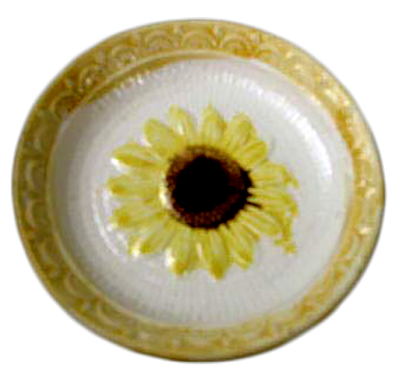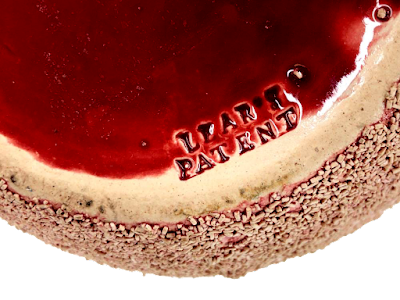Samuel Lear Sunflower oyster plate
Probably the single most famous piece created at the Lear Pottery is the sunflower oyster plate seen above, but as is true of the smaller potteries of Staffordshire, little is known about the company that created it.
Samuel Lear had a brief but memorable career in the manufacture of majolica. Born in 1853 near Hadley, like so many before him, he was a child of the Staffordshire potteries. His father worked as an operator of the kilns at one of the nearby potteries. In 1871 the ambitious young man took a job as a clerk in Hanley learning the pottery trade. By the age of 21 he opened his own business in Hanley, believed to initially be a pottery warehousing business but by the age of 25 expanded to his own pottery at the Mayer Works, manufacturing all forms of earthenware.
Mayer Works pottery
In 1881 he began the manufacture and advertisement of majolica, largely in the Aesthetic taste. The following year he expanded his pottery with additional facilities.
Lear trade advertisement
Although Lear created and registered his own majolica designs it’s ironic that the two majolica patterns that are most closely associated with his name today have origins at other potteries.
The
Wardle water lily pattern is probably the one most associated with the Lear pottery today. It is assumed that since Wardle was a competitor in the majolica market, it was either outright copied from Wardle or possibly a pattern licensed to the Lear company. In any event, it was a design potted by both companies (and probably even by Forester) but most closely associated with Lear today in spite of being a Wardle original.
Lear/Wardle majolica water lily pitcher
Lear/Wardle water lily tea tray
Lear/Wardle water lily tea set
Lear/Wardle majolica mustache cup & saucer
Lear/Wardle majolica cup & saucer
Lear/Wardle lily spooner
Lear/Wardle water lily bread plate
Lear/Wardle water lily vase
The rope and lily pattern was another one originally created at another pottery. This design was registered by James Edwards and Son.
English Registration of Edward's rope and lily design
Edwards & Son salt glaze pitcher
When Edwards & Son foundered in 1881, Lear purchased the molds for the pattern and began producing it in large quantities in majolica expanding its design motifs to different shapes.
Samuel Lear majolica lily and rope jug
Lear majolica rope and lily cheese bell
Lear majolica rope and lily Stilton cheese bell
Majolica lily plate attributed to Lear
One of the earliest registered Lear majolica patterns is the crane pitcher below from 1881.
Lear registered majolica jug
Another registered original design from Lear, this in the aesthetic taste, is Sunflower. While the best known piece of this pattern is the oyster plate at the top of the page there was a complete line created in the pattern.
Lear majolica Sunflower cake plate
Lear majolica Sunflower tray
Lear majolica Sunflower platter
Lear majolica Sunflower mug
Lear Sunflower sardine box
Lear majolica Sunflower mustache cup
Lear majolica Sunflower cup & saucer
Lear majolica Sunflower jug
Lear majolica Sunflower platter
Lear majolica Sunflower punch or salad bowl
Lear majolica Sunflower butter dish
Lear majolica Sunflower dessert plate
Samuel Lear majolica Sunflower sugar bowl
Lear Sunflower teapot
Lear majolica Sunflower butter pat
Lear majolica Sunflower cuspidor
A pattern similar to Sunflower—one that uses many of the same design conventions—is Narcissus.
Samuel Lear majolica Narcissus tazza
Samuel Lear majolica Narcissus oyster plate
Lear majolica Narcissus pitcher
Lear majolica Narcissus ice cream dish
Samuel Lear majolica Narcissus bowl
Samuel Lear majolica Narcissus tea set
Lear majolica Narcissus platter
Samuel Lear majolica Narcissus dessert plate
Samuel Lear majolica Narcissus butter pat
Lear manufactured other original majolica designs, including several modern designs, with designer Christopher Dresser.
Christopher Dresser designed Lear pitcher
Christopher Dresser designed Lear pitcher
Christopher Dresser designed Lear pitcher
Christopher Dresser designed vase for Samuel Lear
Lear also created utilitarian majolica ware such as the ink well, oyster plate and syrup below and work in the Barbotine manner like the basket below.
Samuel Lear majolica inkwell
Samuel Lear majolica oyster plate
Lear grape and strawberry plate
Samuel Lear majolica syrup
Lear majolica basketweave sugar bowl
Lear majolica basket in the Barbotine style
Samuel Lear majolica squirrel jug
Lear Aesthetic majolica basket
Lear majolica begonia leaf
He manufactured a large number of designs in a majolica form he called Mossed Ware but we call sand majolica today, often using the Dresser designed pieces as a base, sometimes decorated with flowers in the Barbotine manner. Some of these later pieces bear the impressed Lear mark.
Lear mark on the grape and strawberry plate above
Lear mark from one of the Christopher Dresser
designed vases above
Lear majolica mark on Mossed Ware
Lear mossed majolica pitcher based on a
design by Christopher Dresser
Samuel Lear mossed majolica vase
Lear majolica mossed bud vase
Lear mossed majolica vase
Samuel Lear mossed majolica vase based on a Dresser design
Lear mossed majolica vase
Mossed Lear majolica vase decorated in the Barbotine manner
Mossed Lear majolica vase
By 1886 Lear developed serious financial problems and plotted to bilk his creditors and leave England. He sent his family ahead to New South Wales in Australia and quietly sold his Mayer Works pottery to Thomas Forester, who most certainly continued the manufacture of Lear products.
Lear sent the money from the sale abroad, boarded a ship and set sail to join his family. Whether he ever arrived in New South Wales is not known, nor is it known if he settled in mainland Australia, Tasmania or New Zealand. What is known is that his body was found in a wrecked ship near New Zealand in 1888. He was 35 years old.








































































